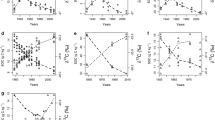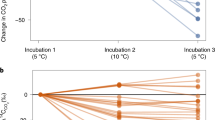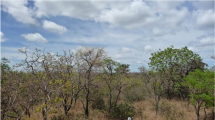Abstract
Studies of changes in soil organic carbon (SOC) stocks normally limit their focus to the upper 20–30 cm of soil, yet 0–20 cm SOC stocks are only ∼40% of 0–1 m SOC. Accounting for only the upper 20–30 cm of SOC has been justifiable assuming that deeper SOC is unreactive since it displays 14C-derived mean residence times of hundreds or thousands of years. The dramatic increase in the 14C content of the atmosphere resulting from thermonuclear testing circa 1963 allows the unreactivity of deep SOC to be tested by examining whether deep soils show evidence of ‘bomb-14C’ incorporation. At depths of 40–100 cm, a well-studied New Zealand soil under stable pastoral management displays progressive enrichment of over 200‰ across samplings in 1959, 1974 and 2002, indicating substantial incorporation of bomb 14C. This pattern of deep 14C enrichment—previously observed in 2 well-drained California grassland soils—leads to the hypothesis that roots and/or dissolved organic C transport contribute to a decadally-reactive SOC pool comprising ∼10–40% of SOC below 50 cm. Deep reactive SOC may be important in the global C cycle because it can react to land-use or vegetation change and may respond to different processes than the reactive SOC in the upper 20–30 cm of soil.



Similar content being viewed by others
References
Ajwa HA, Rice CW, Sotomayor D (1998) Carbon and nitrogren mineralization in tallgrass prarie and agricultural soil profiles. Soil Sci Soc Am J 62:942–951
Baisden WT, Amundson R, Brenner DL, Cook AC, Kendall C, Harden JW (2002a) A multi-isotope C and N modeling analysis of soil organic matter turnover and transport as a function of soil depth in a California annual grassland soil chronosequence. Global Biogeochem Cycles 16:1135, doi:10.1029/2001GB001823
Baisden WT, Amundson R, Cook AC, Brenner DL (2002b) Turnover and storage of C and N in five density fractions from California annual grassland surface soils. Global Biogeochem Cycles 16:1117, doi:10.1029/2001GB001822
Barrett DJ (2002) Steady state turnover time of carbon in the Australian terrestrial biosphere. Global Biogeochem Cycles 16:1108, doi:10.1029/2002GB001860
Gaudinski JB, Trumbore SE, Davidson EA, Zheng SH (2000) Soil carbon cycling in a temperate forest: radiocarbon-based estimates of residence times, sequestration rates and partitioning of fluxes. Biogeochemistry 51:33–69
Gill R, Burke IC, Milchunas DG, Laurenroth WK (1999) Relationship between root biomass and soil organic matter pools in the shortgrass steppe of Eastern Colorado. Ecosystems 2:226–336
Golchin A, Oades JM, Skjemstad JO, Clarke P (1994) Study of Free and Occluded Particulate Organic-Matter in Soils by Solid-State C-13 CP/MAS NMR-Spectroscopy and Scanning Electron-Microscopy. Aust J Soil Res 32:285–309
Harden JW (1987) Soils developed on granitic alluvium near Merced. California, USGS, Bulletin 1590.A
Holloway JM, Dahlgren RA (1999) Geologic nitrogen in terrestrial biogeochemical cycling. Geology 27:567–570
Jackson RB, Banner JL, Jobbagy EG, Pookman WT, Wall DH (2002) Ecosystem carbon loss with woody plant invasion of grasslands. Nature 418:623–626
Jobbagy EG, Jackson RB (2000) The vertical distribution of soil organic carbon and its relation to climate and vegetation. Ecol Appl 10:423–436
Lassey KR, Tate KR, Sparks RJ, Claydon JJ (1996) Historic Measurements of Radiocarbon in New Zealand Soils. Radiocarbon 38:253–270
Manning MR, Gomez AJ, Pohl KP (1994) Atmospheric carbon dioxide record from in situ measurements at Baring Head. CDIAC, Oak Ridge National Laboratory
Metherell AK, Harding LA, Cole CV, Parton WJ (1993) CENTURY Soil Organic Matter Model Environment: Technical Documentation Agroecosystem Version 4.0. (p 249). USDA-ARS, Fort Collins, Colorado
Neff JC, Asner GP (2001) Dissolved organic carbon in terrestrial ecosystems: synthesis and a model. Ecosystems 4:29–48
Neff JC, Chapin FS, Vitousek PM (2003) Breaks in the cycle: dissolved organic nitrogen in terresterial ecosystems. Frontiers Ecol 1:205–211
Nepstad DC, Decarvalho CR, Davidson EA, Jipp PH, Lefebvre PA, Negreiros GH, Dasilva ED, Stone TA, Trumbore SE, Vieira S (1994) The role of deep roots in the hydrological and carbon cycles of Amazonian forests and pastures. Nature 372:666–669
O’Brien BJ, Stout JD (1978) Movement and turnover of soil organic matter as indicated by carbon isotope measurements. Soil Biology and Biochemistry 10:309–317
Osher LJ, Matson PA, Amundson R (2003) Effect of land use change on soil carbon in Hawaii. Biogeochemistry 65:213–232
Parfitt RL, Saigusa M, Eden DN (1984) Soil development processes in an Aqualf-Ochrept sequence from loess with admixtures of tephra, New Zealand. J Soil Sci 35:625–640
Parshotam A (1996) The Rothamsted soil-carbon turnover model – discrete to continuous form. Ecol Modelling 86:283–289
Parton WJ, Ojima DS, Schimel DS (1996) Models to evaluate soil organic matter storage and dynamics. In: Carter MR, Stewart BA (eds) Structure and organic matter storage in agroecosystems. CRC Press, New York, pp 421–448
Paul E, Follet R, Leavitt S, Halvorson A, Peterson G, Lyon D (1997) Radiocarbon dating for determination of soil organic matter pool sizes and dynamics. Soil Sci Soc Am J 61:1058–1068
Perakis SS, Hedin LO (2002) Nitrogen loss from unpolluted South American forests mainly via dissolved organic compounds. Nature 415:416–419
Post WM, Emanuel WR, Zinke PJ, Stangenberger AG (1982) Soil carbon pools and world life zones. Nature 298:156–159
Richter DD, Markewitz D (1995) How deep is soil? Bioscience 45:600–609
Saunders WMH, Metson AJ (1971) Seasonal variation of phosphorous in soil and pasture. NZ J Agric Res 14:307–328
Schimel JP, Bennett J (2004) Nitrogen mineralization: challenges of a changing paradigm. Ecology 85:591–602
Sheffield University (1994) Genetic Algorithm Toolbox. University of Sheffield, Sheffield
Smith P, Smith JU, Powlson DS, McGill WB, Arah JRM, Chertov OG, Coleman K, Franko U, Frolking S, Jenkinson DS, Jensen LS, Kelly RH, Klein-Gunnewiek H, Komarov AS, Li C, Molina JAE, Mueller T, Parton WJ, Thornley JHM, Whitmore AP (1997) A comparison of the performance of nine soil organic matter models using datasets from seven long-term experiments. Geoderma 81:153–225
Torn MS, Lapenis AG, Timofeev A, Fisher ML, Babikov BV, Harden JW (2002) Organic carbon and carbon isotopes in modern and 100-year-old-soil archives of the Russian steppe. Global Change Biol 8:941–953
Trumbore SE (1993) Comparison of carbon dynamics in tropical and temperate soils using radiocarbon measurements. Global Biogeochem Cycles 7:275–290
Trumbore SE (1997) Potential responses of soil organic carbon to global environmental change. Proc National Acad Sci USA 94:8284–8291
Trumbore SE (2000) Age of soil organic matter and soil respiration: radiocarbon constraints on belowground dynamics. Ecol Appl 10:399–411
Trumbore SE, Davidson EA, Decamargo PB, Nepstad DC, Martinelli LA (1995) Belowground cycling of carbon in forests and pastures of Eastern Amazonia. Global Biogeochem Cycles 9:515–528
Veldkamp E, Becker A, Schwendenmann L, Clark DA, Schulte-Bisping H (2003) Substantial labile carbon stocks and microbial activity in deeply weathered soils below a tropical wet forest. Global Change Biol 9:1171–1184
Wang Y, Amundson R, Trumbore S (1999) The impact of land use change on C turnover in soils. Global Biogeochem Cycles 13:47–57
Xu T, White L, Hui D, Luo Y (2006) Probabilistic inversion of a terrestrial ecosystem model: Analysis of uncertainty in parameter estimation and model prediction. Global Biogeochem Cycle 20:GB2007, doi:2010.1029/2005GB002468
Acknowledgements
We thank K. Lassey of the National Institute for Water and Atmospheric Research, NZ, for the record of atmospheric radiocarbon content at Baring Head, New Zealand. J. Neff, K. Tate, P. Sollins, D. Richter and an anonymous reviewer provided helpful reviews. R. Amundson and J. Harden helped with discussion and interpretation of California profiles. R.H. Wilde assisted with site selection, sampling and soil description. This work was funded by NZ FRST.
Author information
Authors and Affiliations
Corresponding author
Rights and permissions
About this article
Cite this article
Baisden, W.T., Parfitt, R.L. Bomb 14C enrichment indicates decadal C pool in deep soil?. Biogeochemistry 85, 59–68 (2007). https://doi.org/10.1007/s10533-007-9101-7
Received:
Accepted:
Published:
Issue Date:
DOI: https://doi.org/10.1007/s10533-007-9101-7




